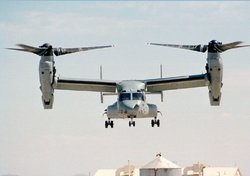Tue, Aug 13, 2024
Fatal Australian Crash One Of Four In Two Years Heightens Scrutiny
A military investigation has concluded that the fatal crash of a Marine V-22 Osprey in August 2023 was due to pilot errors during a midair near-miss. It also found that the squadron involved had issues that permitted a lax culture regarding flight safety.

Two pilots were fatally injured in the accident and a third, the crew chief, was killed when he “heroically reentered the burning cockpit of the aircraft in an attempt to rescue the trapped pilots.”
The crash was one of four involving fatalities in the past two years that have once again stirred the interest of Congress over the Osprey, which has been an important asset for combat and special ops missions but is one of the most complex aircraft to fly and maintain. It also has a troubling history of accidents. In addition to the aircraft aspect, the investigation also brought attention to significant safety concerns within the squadron. In fact, investigators recommended possible administrative action against the squadron’s former commander for permitting “a culture that disregarded safety of flight procedures.” They also recommended possible disciplinary action for a senior maintenance officer for dereliction of duty and falsifying the aircraft’s weight and balance form.

The form should also have been reviewed by the aircraft’s commander but apparently this was not done.
The proximal cause of the accident itself was due to the lead Osprey in a two-ship trailing formation reducing power without informing the trail aircraft. The pilot of the trailing accident aircraft was slow to recognize the rapidly closing gap and the commander, who was the IP, failed to correctly assess the situation or take the controls until it became clear that a steep bank was needed to avoid a mid-air collision. A series of steep banks placed the Osprey into a stall which became unrecoverable and the aircraft went down nose first. The 19 Marines in the back all survived but the two pilots and crew chief were fatally injured.
More News
From 2023 (YouTube Edition): "Ain’t Your Daddy’s Super Cub”—Don Wade Co-owned by Don and Ron Wade—the former of Don’s Dream Machines, a storied >[...]
Pilot-Rated Passenger Reported That The Pilot Did Not Adequately “Round Out” The Landing Flare And The Airplane Bounced And Yawed To The Right Analysis: The pilot state>[...]
Dead Reckoning Dead reckoning, as applied to flying, is the navigation of an airplane solely by means of computations based on airspeed, course, heading, wind direction, and speed,>[...]
Aero Linx: Lake Amphibian Club This website is created and sponsored by the Lake Amphibian Club, to help spread the word about these wonderful, versatile amphibians that can land j>[...]
“I am deeply honored to be sworn in as NASA administrator. NASA’s mission is as imperative and urgent as ever — to push the boundaries of human exploration, ignit>[...]
 Classic Aero-TV: In Praise of Alabamas Patriot Aircraft USA
Classic Aero-TV: In Praise of Alabamas Patriot Aircraft USA NTSB Final Report: Cirrus Design Corp SR22
NTSB Final Report: Cirrus Design Corp SR22 ANN's Daily Aero-Term (12.21.25): Dead Reckoning
ANN's Daily Aero-Term (12.21.25): Dead Reckoning ANN's Daily Aero-Linx (12.21.25)
ANN's Daily Aero-Linx (12.21.25) Aero-News: Quote of the Day (12.21.25)
Aero-News: Quote of the Day (12.21.25)




